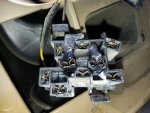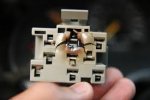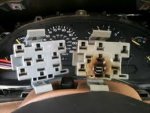broncobuckinaround
New member
- Joined
- Sep 24, 2012
- Messages
- 95
- Reaction score
- 0
- Points
- 0
- Vehicle Year
- 07/86
- Vehicle
- ford
started out i was driving to work, suddenly the car shuts off and smokes come out of the hood. the black with orange stripe wire fusible link had fried and caught fire.
so i began to unravel the loom and traced to the fuse panel and the headlight switch.
i figured it shorted because it got a ground, well using s test light confirmed it. the blk/org wire was being grounded. so in tracing it i found it fuses into multiple things. one being the dome lights. its fused into them so by pulling the fuse the ground went away. simple yeah ok dont need dome lights got flashlights everywhere.
any how i fixed the burnt wires by cutting away all the burnt parts and splicing in a fusible link (30amp fuse).
the problem still exists but only when i turn on the headlights, i found a pin out on here that says what the wires are and where they go. heres the link so anyone reading this can follow me, http://www.broncoiicorral.com/library/headlight_switch_wiring.shtml
H,B2,and I all have a constant ground. doesnt matter if i pull the switch, or the car is running or if the ignition is on or off.
b2 ends up being power for the turn lamps, if i take the bulbs out the ground goes away. thats as far as i made it with that. but thats confusing.
i need further help taking this on. im a great mechanical person. just very bad with electrical.
so i began to unravel the loom and traced to the fuse panel and the headlight switch.
i figured it shorted because it got a ground, well using s test light confirmed it. the blk/org wire was being grounded. so in tracing it i found it fuses into multiple things. one being the dome lights. its fused into them so by pulling the fuse the ground went away. simple yeah ok dont need dome lights got flashlights everywhere.
any how i fixed the burnt wires by cutting away all the burnt parts and splicing in a fusible link (30amp fuse).
the problem still exists but only when i turn on the headlights, i found a pin out on here that says what the wires are and where they go. heres the link so anyone reading this can follow me, http://www.broncoiicorral.com/library/headlight_switch_wiring.shtml
H,B2,and I all have a constant ground. doesnt matter if i pull the switch, or the car is running or if the ignition is on or off.
b2 ends up being power for the turn lamps, if i take the bulbs out the ground goes away. thats as far as i made it with that. but thats confusing.
i need further help taking this on. im a great mechanical person. just very bad with electrical.



